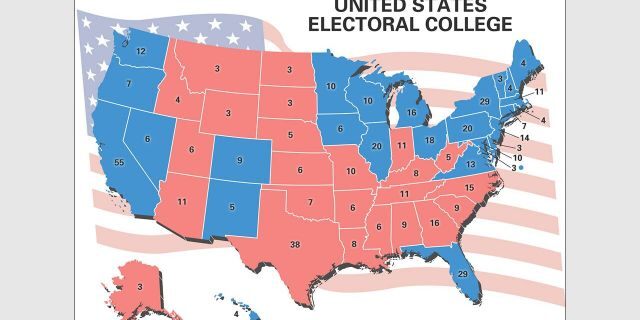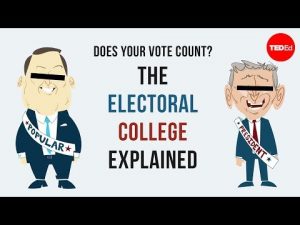
The History & The Why
Established in Article II, Section 1 of the U.S. Constitution, the Electoral College is the formal body which elects the President and Vice President of the United States. Each state has as many “electors” in the Electoral College as it has Representatives and Senators in the United States Congress, and the District of Columbia has three electors. When voters go to the polls in a Presidential election, they actually are voting for the slate of electors vowing to cast their ballots for that ticket in the Electoral College.
In other U.S. elections, candidates are elected directly by popular vote. But the president and vice president are not elected directly by citizens. Instead, they’re chosen by “electors” through this process called the Electoral College.
The process of using electors comes from the Constitution. It was a compromise between a popular vote by citizens and a vote in Congress.

The Electoral College consists of a total of 538 members, one for each U.S. senator and representative, and three additional electors representing the District of Columbia. In modern elections the first candidate to get 270 of the 538 total electoral votes wins the White House.
The 12th and 23rd Amendments modified the modern election process.
The 12th Amendment ratified in 1804 changed the original process, allowing for separate ballots for determining the President and Vice President. The District of Columbia has had three electors since the 23rd Amendment was ratified in 1961.
The 12th Amendment, which allowed each party to designate one candidate for president and a separate candidate for vice president. The amendment’s modifications of the electoral process transformed the Framers’ framework, enabling future presidential elections to be openly populist and partisan affairs featuring two competing parties. It is the 12th Amendment’s Electoral College system, not the Philadelphia Framers’, that remains in place today.

The history of the Electoral College is in part tied to America’s history of slavery.
The Electoral College system, at least partially, originated with Southern leaders during the Constitutional Convention. They feared that their rural, sparsely-populated states would be disadvantaged in presidential elections. As a result, they demanded a system that would tip the scales in their favor, leading to the establishment of the Electoral College.
In a direct election system, the South would have lost every time because a huge percentage of its population was Black slaves, and slaves couldn’t vote. But an Electoral College allows states to count slaves, albeit at a discount (the three-fifths clause), and that’s what gave the South the inside track in presidential elections. And thus it’s no surprise that eight of the first nine presidential races were won by a Virginian. (Virginia was the most populous state at the time, and had a massive slave population that boosted its electoral vote count.)
More than two centuries after it was designed to empower southern white male voters, the system continues to do just that.
Slavery and the Three-Fifths Compromise
The populations in the North and South were approximately equal, but roughly one-third of those living in the South were held in bondage. Because of its considerable, nonvoting slave population, that region would have less clout under a popular-vote system. The ultimate solution was an indirect method of choosing the president, one that could leverage the three-fifths compromise, the Faustian bargain they’d already made to determine how congressional seats would be apportioned. With about 93 percent of the country’s slaves toiling in just five southern states, that region was the undoubted beneficiary of the compromise, increasing the size of the South’s congressional delegation by 42 percent.
But determining exactly how many electors to assign to each state was another sticking point. Here the divide was between slave-owning and non-slave-owning states. It was the same issue that plagued the distribution of seats in the House of Representatives: should or shouldn’t the Founders include slaves in counting a state’s population
The result was the controversial “three-fifths compromise,” in which enslaved Black people would be counted as three-fifths of a person for the purpose of allocating representatives and electors and calculating federal taxes. The compromise ensured that Southern states would ratify the Constitution and gave Virginia, home to more than 200,000 slaves, a quarter of the total electoral votes required to win the presidency.
The Electors Selection Process
State legislatures are responsible for nominating electors. The process can actually differ from state to state. In general, though, the two most common ways are:
- The elector is nominated by his or her state party committee (perhaps to reward many years of service to the party).
- The elector campaigns for a spot and the decision is made during a vote held at the state’s party convention.
Usually, electors are people who are politically active in their party (be it Democrat, Green, Libertarian, Republican or Independent) or connected to the political arena. This includes political activists, party leaders, elected officials of the state and even people who have personal or political ties to the presidential candidates.
While the Constitution makes no mention of qualifications that must be met to become an Electoral College member, it does determine an Electoral College member cannot be:
- a member of Congress
- a high-ranking U.S. official in a position of “trust or profit,” which refers to a member of Congress accepting an appointment to executive office
- someone who has “engaged in insurrection or rebellion” against the U.S.
How many electors are there? How are they distributed among the States?
The Electoral College consists of 538 electors. A majority of 270 electoral votes is required to elect the President. Your State has the same number of electors as it does Members in its Congressional delegation: one for each Member in the House of Representatives plus two Senators.
How are my electors chosen? What are their qualifications? How do they decide who to vote for?
Each candidate running for President in your State has his or her own group of electors (known as a slate). The slates are generally chosen by the candidate’s political party in your State, but State laws vary on how the electors are selected and what their responsibilities are.
Allocation among the States
Electoral votes are allocated among the States based on the Census. Every State is allocated a number of votes equal to the number of senators and representatives in its U.S. Congressional delegation—two votes for its senators in the U.S. Senate plus a number of votes equal to the number of its Congressional districts.Yes, your Vote does Matter.
Dexter McLeod
President/CEO LA South Chamber of Commerce

Recent Comments